Asymptomatic cases unlikely to spread virus

However, anti-epidemic measures will continue across country, experts said
Excluding asymptomatic novel coronavirus cases from the tally of confirmed infections in China is consistent with the country's official diagnosis criteria and is aligned with the mainstream stance that asymptomatic transmission, albeit possible, is not exerting a major impact on the trajectory of the viral pandemic, health authorities have said.
However, this does not mean that anti-epidemic efforts in the country are disregarding the lurking threat of stealth virus carriers. People who test positive but have no symptoms are also subject to rigorous quarantine and monitoring measures, and thus are unlikely to trigger new outbreaks, according to experts.
As the domestic outbreak is winding down, health experts have also called for stepping up preparedness on coping with symptom-free cases and intensifying research into quandaries like the true proportion and contagiousness of the asymptomatic group.
Asymptomatic individuals are defined as those who test positive for the virus but show no signs of infection such as fever, cough or sore throat, according to the diagnosis and treatment guideline released by the National Health Commission.
In China, such cases will be quarantined in centralized facilities for a full incubation period, and if relevant symptoms show, they will be redirected into the pool of confirmed cases and made public. Before being released from isolation, they must test negative twice for the virus-the same requirement applied to regular patients, the guideline said.
"Most asymptomatic cases in China are detected among close-contacts of the infected people who have already been put in individual isolation and carefully monitored. Some of them develop symptoms later and are immediately transferred to hospitals, so they are unlikely to cause widespread community transmission," Wu Zunyou, a chief epidemiologist at the Chinese Center for Disease Control and Prevention, said on Tuesday.
There is also some consensus among public health experts that asymptomatic people are less capable of spreading the virus to others.
According to the report compiled by a team of World Health Organization and Chinese public health experts, the scale of truly asymptomatic infections is unclear but "appears to be rare and does not appear to be a major driver of transmission".
Li Xingwang, a physician with Beijing Ditan Hospital's infectious disease center, said during a news conference in February that the viral load harbored by an infected person is correlated with the severity of symptoms, and thus no symptom can be interpreted as weak transmission capacity.
Zeng Yixin, vice-minister of the National Health Commission, also said previously that due to lack of sneezing and coughing in asymptomatic individuals-crucial acts in the known primary transmission pathway of the contagion-the group is deemed less likely to spread the virus.
No loosening up
But experts and health officials are not loosening their guard as asymptomatic cases have popped up in China and abroad, and there is anecdotal evidence of clusters of infections seeded by covert cases, though more research is needed to verify the transmission process.
In one recent case, a resident in Wuhan reportedly tested positive for the virus twice last week during a hospital visit to check his swollen lymph nodes. But his body temperature was normal and no coughs were recorded. The case is not included in the city's confirmed caseload, Xinhua News Agency reported.
On Monday evening, the Wuhan City Health Commission said in a statement that asymptomatic cases are excluded based on national criteria, and the majority of them do not need extra treatment to clear the virus out of their bodies.
The statement also noted that in addition to being discovered among close-contacts, asymptomatic cases also surface during intensive testing programs as part of the epidemiologic research on regional outbreaks or the tracing of infection sources.
Wu Hao, a member of the commission's expert team stationed in Wuhan, said there are likely some undetected infected people in local communities.
"We will continue to ramp up screening and education on disease control knowledge so the public will be mobilized to help us identify possible remaining cases as soon as possible," he said during an interview with China Central Television on Friday.
Wang Chen, head of the Chinese Academy of Medical Sciences, said that since the peak of the domestic outbreak has passed, it is now vital and urgent to ramp up epidemiological research to obtain a firmer grip on the scale of infections in hard-hit areas like Wuhan.
"If we can find some virus carriers, asymptomatic cases or maybe chronic cases through wider nucleic acid or antibody testing, these findings will be of great significance to the family and community of the affected individual, as well as to the overall epidemic control effort," he told Xinhua.
Please feel free to contact us by sending your questions to question@chinadaily.com.cn or commenting on China Daily app. We will ask experts to answer them.














